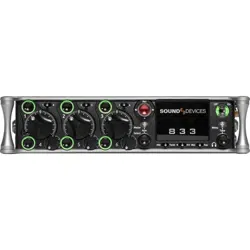Loading ...
Loading ...
Loading ...

greatly improved audio by turning down the inputs that aren’t used and automatically turning up the inputs that are being used in
real-time and transparently.
Mix track
A recorded track that is a sum of multiple tracks. In production sound the mix track is often a single summed track of all production
dialog elements. Mix tracks can also be sub-mixes of like microphones, such as a sub mix of just lavalier microphones or just boom
microphones.
Monophonic WAV
A WAV file that is comprised of a single track of audio. When recording multi-track audio with monophonic WAV files each track is
recorded to its own WAV file, with a file name indicating the track number. All associated monophonic files that are part of a
multi-track recording will be identical lengths.
Mute
A mute control is a convenient on/off switch for a channel and an easy way to remove a channel from appearing in downstream
buses. Mute an input or channel does not change levels or settings; when channels are muted and unmuted, their settings remain.
Notes (metadata)
A metadata field that is saved along with audio data in a recorded sound file, useful for sound report generation. Some workstation
software recognizes the notes field and presents it when viewing the sound file.
NoiseAssist™
An exclusive Sound Devices noise suppression algorithm which is available as an optional paid plugin from
store.sounddevices.com. Use NoiseAssist to suppress background noises such as traffic, generators, HVAC noise, and more. The
plugin continuously monitors background noise to give you clean audio for the entire take. Up to eight instances of NoiseAssist can
run on any combination of isolated channels (excluding 17-32 on Scorpio), bus L, or bus R.
NP-1(A) battery
A specific class of battery, originally developed by Sony. There are multiple chemistries in this class including lithium-ion and
nickel-cadmium.
Output
The physical connection and associated signal type sent from a device. Outputs can be source from inputs, buses, record tracks,
and other auxiliary signals.
Output auto-mute
When set, an output signal is muted when recording is stopped, restricting program audio from being sent to listeners “between
takes”.
Output delay
A digital delay applied at the output. Signal delay is often set at an output to compensate for the delay introduced by digital imaging
systems so that picture and sound remain in correct “lip sync”. Output delay is set in either frames or milliseconds.
Pan
When a channel is routed to a stereo-linked bus the level it appears at each bus is adjusted by a pan control. A channel with its pan
control “straight up the center”, or “centered” sends signal at the same level to each bus. A channel that is panned left or right sends
the signal to the left or right bus, respectively.
PFL, pre-fade listen
When an input or channel is selected for monitoring/solo with a PFL, the channel is routed to the headphone output before the
channel fader so that the fader position has no effect on the headphone level. Trim/gain changes to the input will change the
headphone output.
Phantom power
Condenser (capacitor) microphones require power for operation. They use power to charge the diaphragm backplate (for true
condensers) and power the impedance convert located adjacent to the microphone capsule. Phantom power is the method for
microphone inputs to supply DC power to the microphone through the same connection used for the audio signals from the
microphone.
Phantom power provides a positive voltage, typically between 11-52 VDC, with 48 V being the most common, on both pin-2 and
pin-3 with pin-1 used as ground. The DC voltage appears as a common-mode signal on the balanced connection and is rejected by
the connection’s differential amplifier. Phantom power has no effect on dynamic microphones.
833 User Guide 116
Loading ...
Loading ...
Loading ...
